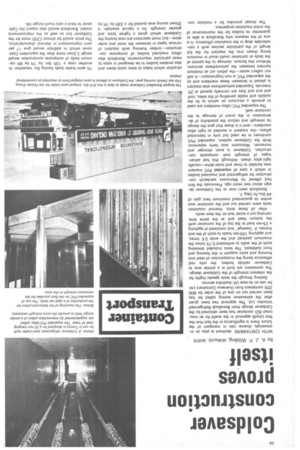Coldsaver construction proves itself
Page 60

If you've noticed an error in this article please click here to report it so we can fix it.
by A. J. P. Wilding, MIMechE, MIRTE
WITH CONTAINERS destined to play an increasingly diverse role in transport of the future there is significance in the fact that the first Lloyd's approval in the world for an insulated ISO container has been obtained by the Coldsaver design from Bonallack Refrigerated Vehicles Ltd. The approval has been given after the exhaustive testing called for has been carried out on one of the order for 800 20ft containers from Overseas Containers Ltd. for use on its new UK-Australia service.
Getting through the tests speaks highly for the inherent strength of the Coldsaver design. The containers are built in a similar way to Coldsaver vehicle bodies, the only real difference being the incorporation of steel end framing and extra support in the flooring and front bulkhead. The tests included stressing each of the walls to withstand 0.75 times the maximum payload and the ends 0.5 times, and applying 100-ton loads to each of the end frames. A "lozenge" test consisted of applying a 25-ton load to the top of the container with the bottom fixed and at the same tiLme carrying out a water test on the door seals.
After all these tests, thermal insulation tests were carried out and the container was within its guaranteed maximum heat gain of 44 Btu /hr /deg. F.
Bonallack went over to the Coldsaver design about two years ago. Previously the firm had offered its Monocore sandwich construction for refrigerated and insulated bodies in which a core of expanded PVC insulant was bonded to inner and outer skins—usually light-alloy sheet. Although this had advantages of strength over composite construction, Coldsaver is even stronger and moreover, Monocore was fairly expensive. With the Coldsaver system, expanded PVC continues to be used but only in fabricated pillars—the insulant is bonded to light alloy members—and it is these that give the design its strength and reduce the possibility of deterioration in the event of damage to the container wall.
The expanded PVC/alloy members are used to provide a structure on which to fix the outside and inside panelling of the sides, roof and end and they are normally spaced at 2ft intervals. Expanded polyurethane slab' insulant is placed in between these members and as the expanded PVC is non-hygroscopic—it will not collect water—the pillars act as moisture barriers between the polyurethane sections. Without this feature, damage to the panels of the body or container could result in moisture being drawn into the insulant for the full length of the particular section with a considerable drop in the insulation efficiency. It is one of the reasons why Bonallack is able to guarantee its bodies for the maintenance of the initial insulation properties.
The design provides for a modular con
struction which helps to keep costs down and also enables bodies to be designed in sizes to meet particular requirements. Bonallack also offers insulated bodies of composite construction—timber framing with insulant of various types in between the inner and outer skins—but most operators are now buying the Coldsaver which gives a lighter body and greater strength. As a typical example, 'a 30cwt saving was quoted for a 33ft by 7ft by 7ft semi-trailer body having 5in. insulation. In another case a 13ft 6in. by 7ft by 6ft icecream body of composite construction would weigh 2.3cwt more than the equivalent Coldsaver which in addition would give 17 per cent improvement in thermal characteristics. The price would be almost £200 more for the Coldsaver but as well as the improvements stated, Bonallack would also expect the Coldsaver to have a very much longer life.




















































































































